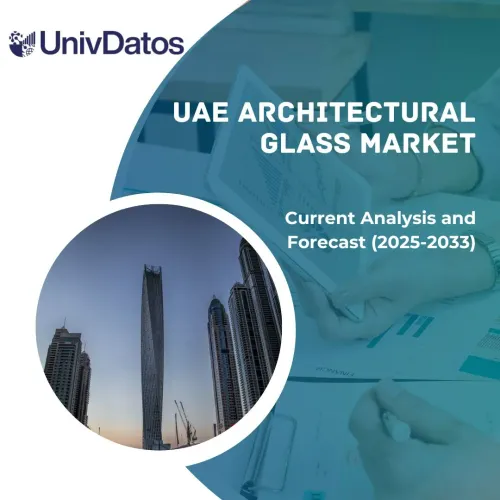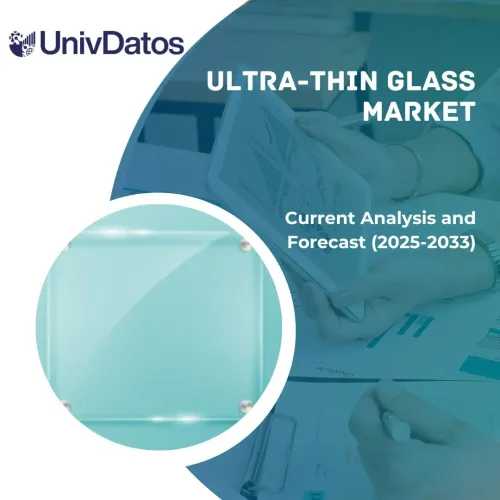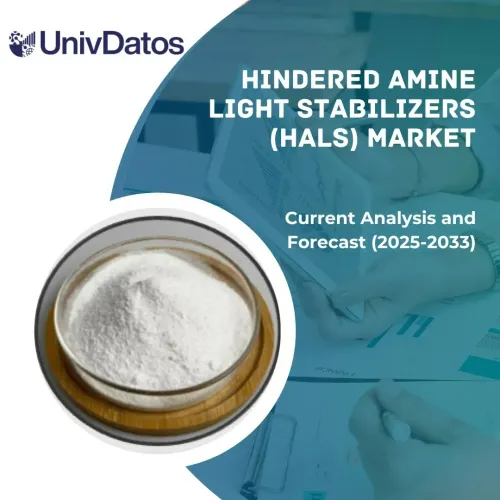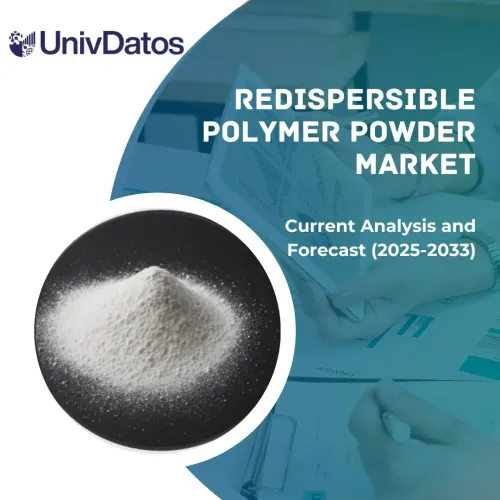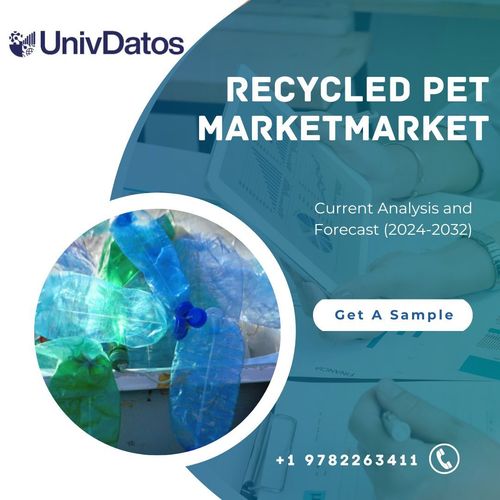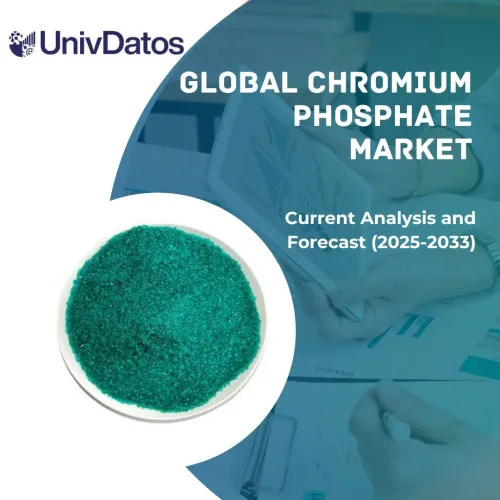- Home
- About Us
- Industry
- Services
- Reading
- Contact Us
Polyetherimide Market: Current Analysis and Forecast (2025-2033)
Emphasis on Grade (Unreinforced and Reinforced); Form (Sheet, Rod, Granule, and Film); Application (Automotive, Aerospace, Electronics, Pharmaceutical, Industrial, Consumer, and Food); and Region/Country
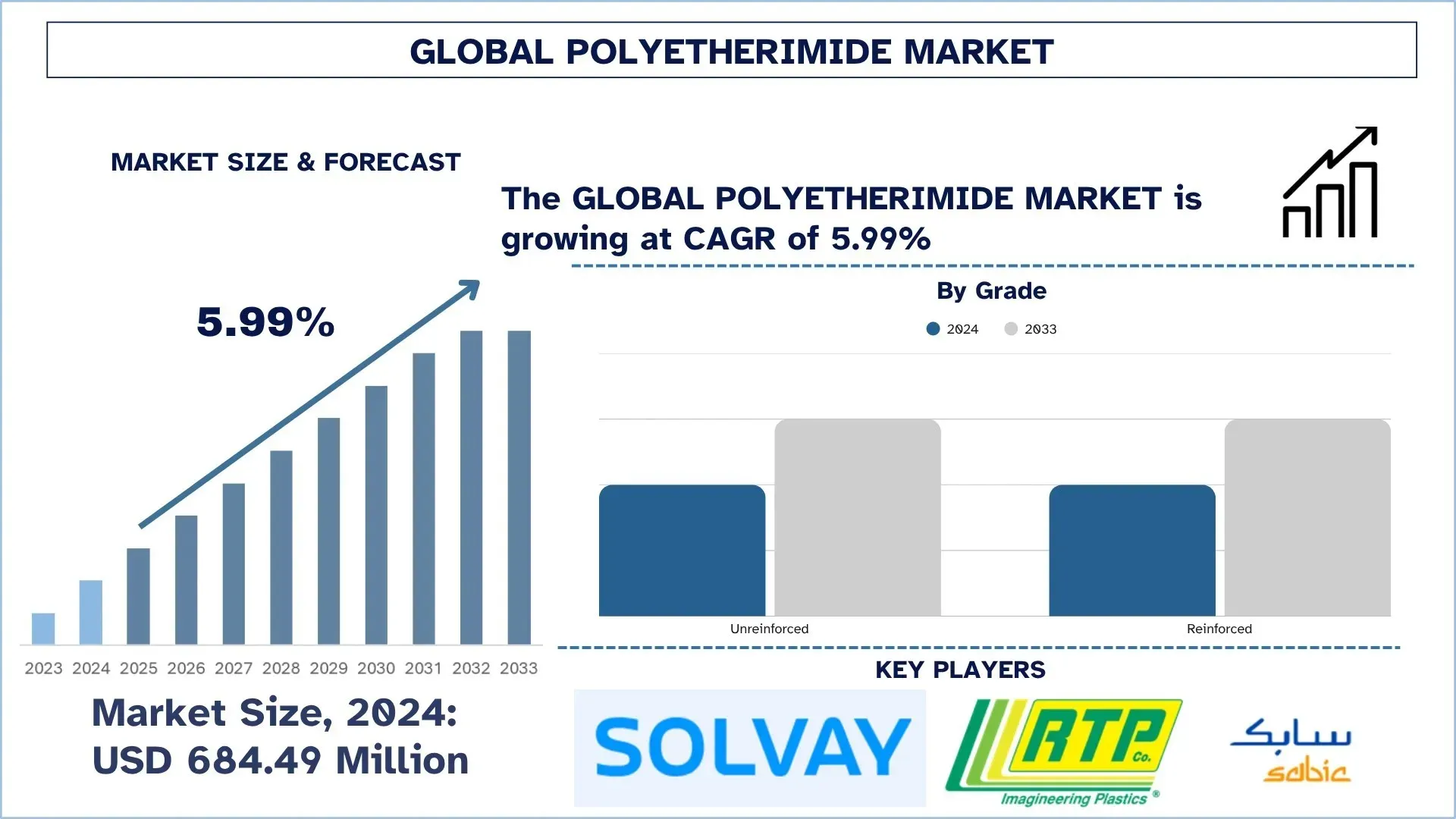
Global Polyetherimide Market Size & Forecast
The Global Polyetherimide Market was valued at USD 684.49 million in 2024 and is expected to grow at a CAGR of around 5.99% during the forecast period (2025-2033F), driven by the growing adoption of light‑weighting & metal replacement in EVs and aircraft, and the booming electronics & 5G hardware production, especially in the Asia‑Pacific region.
Polyetherimide Market Analysis
The polyetherimide market continues to grow as manufacturers seek out strong, lightweight plastics with high-temperature and intense-use tolerance. Polyetherimide (PEI) is available to customers in pellet, sheet, rod, and film form and can be molded, pressed, or 3-D-printed into final products. Car makers are using it to manufacture lighter dashboards, battery boxes, and under-hood connectors; aerospace companies are incorporating it into cabin panels and air ducts, and electronic companies are using it to create phone lenses, 5 G antenna covers, and small sockets that have to remain steady when hot. Since PEI can substitute metal, keep it naturally flame-resistant, firms are decreasing vehicle mass, fuel consumption, and implementing stronger regulations on recycling and hazardous materials. The resin is also preferred in hospitals and food processors due to its ability to withstand the rigorous process of repeated steam cleaning without compromising its strength. The world suppliers continue to introduce lower‑flow, fiber-reinforced grades, and the recently growing 3D-printing industry is being supplied with new powder and filament products. With governments choosing to stimulate electric cars, more environmentally friendly airplanes, and rapid communication devices, PEI ranks high in terms of its unsurpassed durability and lightweight, long life, which are all likely to ensure that the market continues to rise and shine worldwide.
Global Polyetherimide Market Trends
This section discusses the key market trends that are influencing the various segments of the global polyetherimide market, as found by our team of research experts.
Rapid Adoption in Additive Manufacturing
Polyetherimide (PEI) is a robust and high-temperature plastic that has found applications in a wide variety of industries, including aerospace, automobile, and medical. One notable trend is the rapid and expanding adoption of 3D printing, also known as additive manufacturing, to print parts in PEI. This is achieved because 3D printing enables individuals to print sophisticated and customized shapes faster and with less waste, in most cases, at a lower cost than traditional manufacturing processes would require.
PEI is an excellent recipient of a 3D print as it can withstand intense temperatures, is very durable, and is resistant to breaking. This makes it applicable in components that require a long lifespan, even under extreme conditions. To illustrate, airplane parts, car parts, and even medical tools are made using PEI.
The ease of use of 3D printing machines today, combined with their increased sophistication, is encouraging other firms to incorporate PEI into their products. It also supports faster testing of new designs, and this accelerates product development. The relatively steep increase in the application of 3D printing with PEI is transforming the productivity of the products and saving businesses time and money as they produce superior and more reputable pieces. Therefore, rapid adoption in additive manufacturing is a key trend in the polyetherimide market.
Polyetherimide Industry Segmentation
This section provides an analysis of the key trends in each segment of the global polyetherimide market report, along with forecasts at the global, regional, and country levels for 2025-2033.
The Reinforced Segment Dominates the Polyetherimide Market
Based on grade, the polyetherimide market is segmented into Unreinforced and Reinforced. In 2024, the Reinforced segment dominated the market and is anticipated to continue its leadership throughout the forecast period. Increased application in high-performance areas like aerospace, automotive, and electronics has made the demand for reinforced PEI rather high. Such industries need the material that can resist high temperatures, mechanical load, and corrosive chemicals, which reinforced PEI is superior at. The reinforcement of PEI will expand as the industry's demand for stronger and more sustainable components increases. Additionally, the manufacturing technologies of injection molding and 3D printing have emerged due to technological breakthroughs that allow a more refined design of reinforced PEI parts with complex geometry and exposed details. This is especially useful in such industries as aerospace or automotive, where lightweight and high-performance materials are paramount. With industries seeking to make the products lighter, particularly in the automotive and aerospace sectors, to enhance fuel economy, lightweight but strong materials have increasingly become acceptable. Reinforced PEI has the strength and stability necessary in such applications and does not significantly increase the weight of a product, which is an advantage.
The Granule Category held the Largest Market Share in the Polyetherimide Market.
Based on form, the polyetherimide market is segmented into Sheet, Rod, Granule, and Film. In 2024, the granule segment held the largest share and is expected to remain at the top for the next few years. The granules are much preferred as they present ease of processing and excellence in material handling. They are widely employed in the extrusion and injection molding processes, which are part and parcel of numerous industries, e.g., automotive, aerospace, or electronics. This granule shape enables you to have a uniform and accurate control over the molding process, resulting in the manufacture of quality and reliable components. Polyetherimide granules could simply be modified and mixed with different additives to make a specific character, like high flame retardancy, high conductivity, or UV resistance. This customization capability serves to render granules suitable for use in varied industries where special properties of materials are needed. The granules are generally affordable than the other types of polyetherimide (sheets or films) in case of a large production. Their large capacity for handling and convenient storage ability make them appealing to manufacturers aiming at expanding their production without spending too much, thus making the segment enjoy a corner in the market.
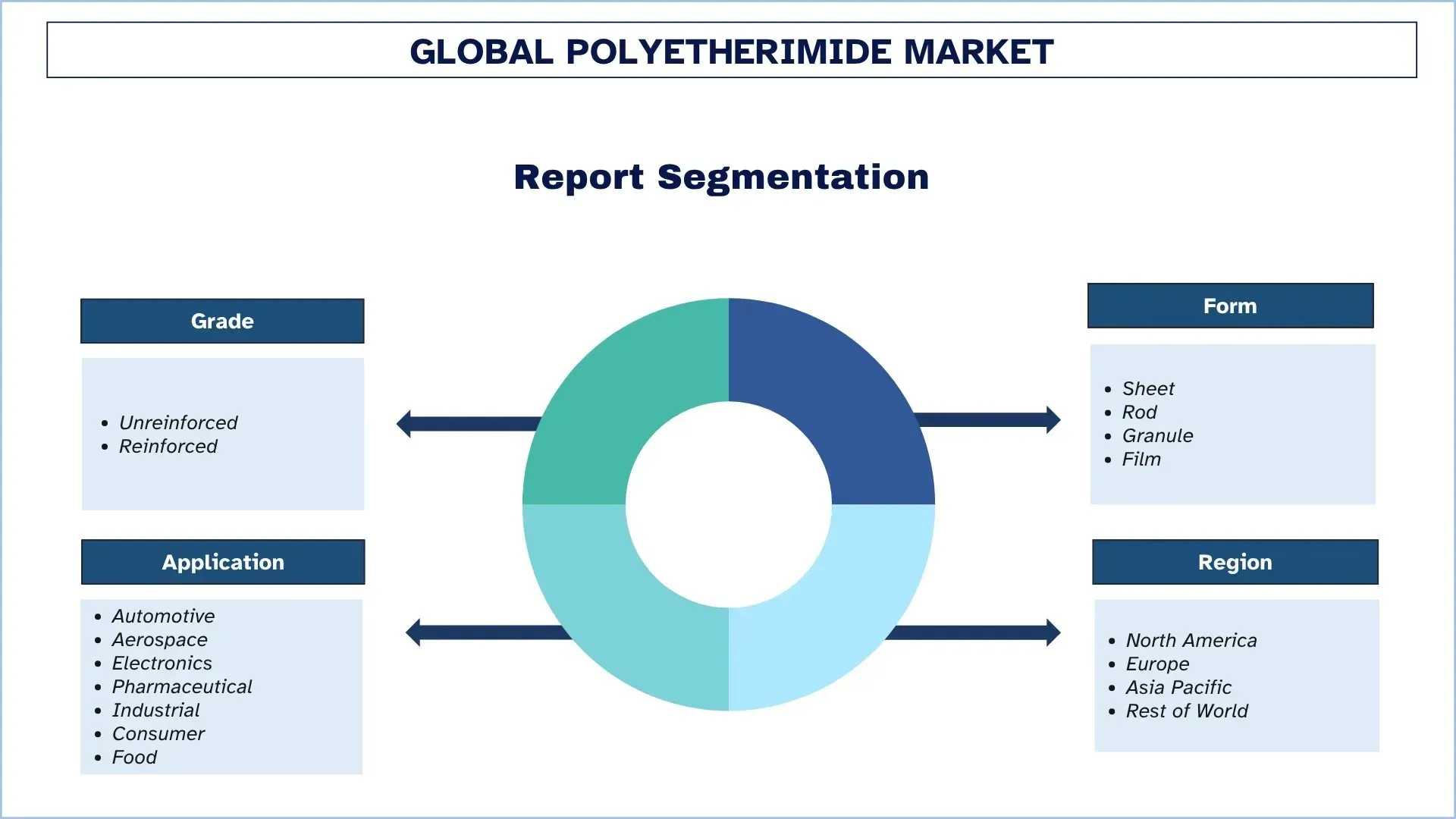
Asia Pacific Dominated the Global Polyetherimide Market
Asia Pacific leads the market presently in polyetherimide, and it is also likely to dominate the market in the forecast period. The dominance is primarily due to the large electronics and semiconductor production base in the region, the fast-growing electric-vehicle and battery manufacturing sector, and the progressive transition to lightweight, flame-resistant polymer materials in motor vehicles and aircraft parts. Large plants of PEI resin and compounders are available in China and Japan, so local cost-effective supply can be done, and at the same time, large-scale OEMs make use of material content in 5G antenna housing, high-temperature connectors, and EMI shielded modules. Government Policies like the Made in China 2025 plan, the Production-Linked Incentives (PLI) programs in India, and the investment in high‑speed rail and aircraft projects hasten the demand even more. Moreover, current PEI application businesses, such as the medical-device and food-package industries in the Asia Pacific, are mainly due to its ability to meet super strict sterilization and sanitary requirements. The miniaturization of additive-manufacturing hubs in Singapore, South Korea, and mainland China lends itself to wider adoption of PEI powder and filament for rapid prototyping and smaller manufacturing facilities. As region-based manufacturers focus more on reducing weight, thermal management, and regulatory compliance, the share of Asia-Pacific in the demand for polyetherimide is likely to override that of the rest of the regions throughout the forecast period.
China held a dominant Share of the Asia Pacific Polyetherimide Market in 2024
China has been growing as a giant in the polyetherimide market globally, supported by robust government industrial policies, technology-driven metropolises like Beijing, Shanghai, and Shenzhen, and massive investments with the assistance of government guidance funds to the efforts of the Made in China 2025 scheme. More aggressive fiscal incentives packages that China announced at the end of 2024 should continue to boost chemical/specialty polymer demand, including PEI, into 2025 and beyond. Domestic producers have made various efforts in building up capacities and interest in introducing eco-compliant, food-contact compliant PEI grades in kitchenware and electric component applications, led by the availability of low-cost labor and subsidized research and development, as well as a rising local champion. Together, the dynamics make China the fastest-growing regional market as well as the strategic production base in the evolving global polyetherimide market.

Polyetherimide Industry Competitive Landscape
The global polyetherimide market is competitive, with several global and international market players. The key players are adopting different growth strategies to enhance their market presence, such as partnerships, agreements, collaborations, new product launches, geographical expansions, and mergers and acquisitions.
Top Polyetherimide Manufacturing Companies
Some of the major players in the market are Solvay SA, RTP Company, SABIC, Ensinger, Mitsubishi Chemical Group, Westlake Plastics, Aikolon Oy, Eagle Performance Plastics Inc., Emco Industrial Plastics, and GEHR.
Recent Developments in the Polyetherimide Market
In 2024, SABIC, a global diversified chemicals company, announced the official opening of its new USD170 million ULTEM resin manufacturing facility in Singapore, and the first advanced specialty chemical manufacturing plant in the region that produces the high-performance thermoplastic, ULTEM resin. The new plant is a strategic interest to accommodate the target of SABIC to step up its worldwide production of the ULTEM specialty resins by over 50 percent to keep up with the upsurge in demand of the high-tech industry and production types in Asia and the Pacific, including Japan and China.
In August 2022, SABIC expanded its ULTEM resin optical material line to promote the use of single-mode fiber optics. The new PEI resin has a much lower coefficient of thermal expansion (CTE) than typical ULTEM grades. ULTEM 3310TD resin provides the efficiency of high-volume micro-molding, reducing the need for costly secondary procedures, increasing design flexibility, and reducing part weight.
Global Polyetherimide Market Report Coverage
Details | |
Base year | 2024 |
Forecast period | 2025-2033 |
Growth momentum | Accelerate at a CAGR of 5.99% |
Market size 2024 | USD 684.49 Million |
Regional analysis | North America, Europe, APAC, Rest of the World |
Major contributing region | Asia Pacific is expected to dominate the market during the forecast period. |
Key countries covered | U.S., Canada, Germany, U.K., Spain, Italy, France, China, Japan, and India |
Companies profiled | Solvay SA, RTP Company, SABIC, Ensinger, Mitsubishi Chemical Group, Westlake Plastics, Aikolon Oy, Eagle Performance Plastics Inc., Emco Industrial Plastics, and GEHR. |
Report Scope | Market Trends, Drivers, and Restraints; Revenue Estimation and Forecast; Segmentation Analysis; Demand and Supply Side Analysis; Competitive Landscape; Company Profiling |
Segments Covered | By Grade; By Form; By Application; By Region/Country |
Reasons to Buy Polyetherimide Market Report:
The study includes market sizing and forecasting analysis confirmed by authenticated key industry experts.
The report briefly reviews overall industry performance at a glance.
The report covers an in-depth analysis of prominent industry peers, primarily focusing on key business financials, type portfolios, expansion strategies, and recent developments.
Detailed examination of drivers, restraints, key trends, and opportunities prevailing in the industry.
The study comprehensively covers the market across different segments.
Deep dive regional-level analysis of the industry.
Customization Options:
The global polyetherimide market can further be customized as per the requirements or any other market segment. Besides this, UnivDatos understands that you may have your own business needs; hence, feel free to contact us to get a report that completely suits your requirements.
Table of Content
Research Methodology for the Global Polyetherimide Market Analysis (2023-2033)
We analyzed the historical market, estimated the current market, and forecasted the future market of the global polyetherimide market to assess its application in major regions worldwide. We conducted exhaustive secondary research to gather historical market data and estimate the current market size. To validate these insights, we carefully reviewed numerous findings and assumptions. Additionally, we conducted in-depth primary interviews with industry experts across the polyetherimide value chain. After validating market figures through these interviews, we used both top-down and bottom-up approaches to forecast the overall market size. We then employed market breakdown and data triangulation methods to estimate and analyze the market size of industry segments and sub-segments.
Market Engineering
We employed the data triangulation technique to finalize the overall market estimation and derive precise statistical numbers for each segment and sub-segment of the global polyetherimide market. We split the data into several segments and sub-segments by analyzing various parameters and trends, including grade, form, application, and regions within the global polyetherimide market.
The Main Objective of the Global Polyetherimide Market Study
The study identifies current and future trends in the global polyetherimide market, providing strategic insights for investors. It highlights regional market attractiveness, enabling industry participants to tap into untapped markets and gain a first-mover advantage. Other quantitative goals of the studies include:
Market Size Analysis: Assess the current market size and forecast the market size of the global polyetherimide market and its segments in terms of value (USD).
Polyetherimide Market Segmentation: Segments in the study include areas of grade, form, application, and regions.
Regulatory Framework & Value Chain Analysis: Examine the regulatory framework, value chain, customer behavior, and competitive landscape of the polyetherimide industry.
Regional Analysis: Conduct a detailed regional analysis for key areas such as Asia Pacific, Europe, North America, and the Rest of the World.
Company Profiles & Growth Strategies: Company profiles of the polyetherimide market and the growth strategies adopted by the market players to sustain the fast-growing market.
Frequently Asked Questions FAQs
Q1: What is the global polyetherimide current market size and its growth potential?
The global polyetherimide market was valued at USD 684.49 million in 2024 and is expected to grow at a CAGR of 5.99% during the forecast period (2025-2033).
Q2: Which segment has the largest share of the global polyetherimide market by grade?
The reinforced segment dominated the market and is expected to maintain its leadership throughout the forecast period, driven by its increased application in high-performance sectors such as aerospace, automotive, and electronics.
Q3: What are the driving factors for the growth of the global polyetherimide market?
• Light-weighting & Metal Replacement in EVs and Aircraft: PEI's strength-to-weight ratio makes it ideal for replacing metals in electric vehicles and aerospace, improving efficiency and fuel economy.
• Booming Electronics & 5G Hardware Production: Its excellent thermal and electrical properties make PEI a key material in next-gen electronics and 5G infrastructure.
• Regulatory Push for Halogen‑Free, Recyclable High‑Performance Plastics: Global regulations are encouraging the shift to halogen-free, recyclable polymers like PEI for safer, sustainable manufacturing.
Q4: What are the emerging technologies and trends in the global polyetherimide market?
• Rapid Adoption in Additive Manufacturing: PEI is increasingly used in 3D printing for its high heat resistance and dimensional stability in aerospace and medical applications.
• Adoption of Carbon‑Fiber‑Reinforced and Glass‑Fiber‑Reinforced Grades: Enhanced PEI grades with carbon or glass fibers are gaining traction for their superior strength, stiffness, and performance in demanding engineering environments.
Q5: What are the key challenges in the global polyetherimide market?
• High Resin and Compounding Cost: The premium cost of PEI resin and complex compounding processes limits its adoption in cost-sensitive applications.
• Competition from Lower‑Cost Substitutes: Alternative engineering plastics like PEEK and PPS pose a challenge by offering similar properties at more competitive prices.
Q6: Which region dominates the global polyetherimide market?
Asia Pacific currently holds the leading position in the global polyetherimide market and is expected to retain its dominance throughout the forecast period. The region's growth is propelled by the rapid adoption of modern agricultural practices, a strong shift toward organic cultivation, and the increasing use of eco-friendly inputs by commercial-scale farmers.
Q7: Who are the key players in the global polyetherimide market?
Some of the key companies include:
• Solvay SA
• RTP Company
• SABIC
• Ensinger
• the Mitsubishi Chemical Group of companies
• Westlake Plastics
• Aikolon Oy
• Eagle Performance Plastics, Inc.
• Emco Industrial Plastics
• GEHR
Q8: How are leading manufacturers enhancing production efficiency in the polyetherimide market?
• Automation & Digitalization: Companies are adopting Industry 4.0 practices, including process automation and predictive maintenance, to optimize throughput and minimize downtime.
• Localized Production Hubs: To reduce lead times and logistics costs, manufacturers are setting up regional compounding and extrusion facilities closer to end-user markets.
• Energy-Efficient Technologies: Integration of energy-saving systems in resin processing and polymerization lines is helping cut operational costs and environmental impact.
Q9: What role does sustainability play in product development strategies within the polyetherimide market?
• Eco-Compliant Formulations: Manufacturers are increasingly focused on developing halogen-free, recyclable PEI grades to align with global sustainability standards.
• Closed-Loop Manufacturing: Some firms are implementing recycling and reuse strategies for PEI scrap, particularly in electronics and automotive applications.
• Certifications & Audits: Gaiing certifications like RoHS, REACH, and UL environmental marks has become a core part of product positioning and regulatory compliance.
Related Reports
Customers who bought this item also bought

